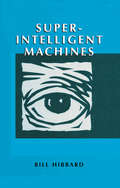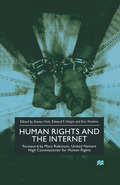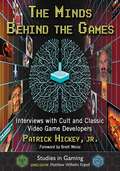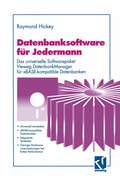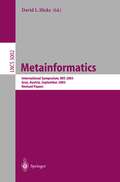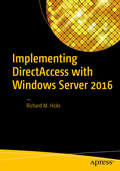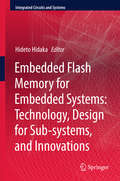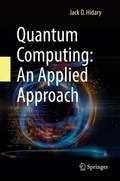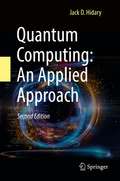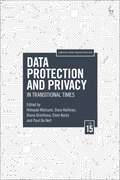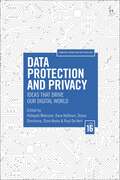- Table View
- List View
Exploring Abstract Algebra With Mathematica®
by Allen C. Hibbard Kenneth M. LevasseurThis upper-division laboratory supplement for courses in abstract algebra consists of several Mathematica packages programmed as a foundation for group and ring theory. Additionally, the "user's guide" illustrates the functionality of the underlying code, while the lab portion of the book reflects the contents of the Mathematica-based electronic notebooks. Students interact with both the printed and electronic versions of the material in the laboratory, and can look up details and reference information in the user's guide. Exercises occur in the stream of the text of the lab, which provides a context within which to answer, and the questions are designed to be either written into the electronic notebook, or on paper. The notebooks are available in both 2.2 and 3.0 versions of Mathematica, and run across all platforms for which Mathematica exits. A very timely and unique addition to the undergraduate abstract algebra curriculum, filling a tremendous void in the literature.
Super-Intelligent Machines (Ifsr Ser.)
by Bill HibbardSuper-Intelligent Machines combines neuroscience and computer science to analyze future intelligent machines. It describes how they will mimic the learning structures of human brains to serve billions of people via the network, and the superior level of consciousness this will give them. Whereas human learning is reinforced by self-interests, this book describes the selfless and compassionate values that must drive machine learning in order to protect human society. Technology will change life much more in the twenty-first century than it has in the twentieth, and Super-Intelligent Machines explains how that can be an advantage.
Studies in Ada Style
by P. Hibbard A. Hisgen J. Rosenberg M. Shaw M. ShermanThe major problems of modern software involve finding effective techniques and tools for organizing and maintaining large, complex programs. The key concept in modern programming for controlling complexity is abstraction; that is, selective emphasis on detail. This monograph discusses how the Ada programming language provides ways to support and exploit such abstraction techniques. The monograph is organized into two parts. The first part traces the important ideas of modern programming languages to their roots in the languages of the past decade and shows how modern languages, such as Ada, respond to contemporary problems in software development. The second part examines five problems to be programmed using Ada. For each problem, a complete Ada program is given, followed by a discussion of how the Ada language affected various design decisions. These problems were selected to be as practical as possible rather than to illustrate any particular set of language features. Much of this material has appeared previously in print. An earlier version of the first section, by Mary Shaw, was published as "The Impact of Abstraction Concerns on Modern Programming Languages" in the Proceedings of the IEEE special issue on Software Engineering, September 1980, Vol. 68, No. 9, pages 1119·1130. It is reprinted with the IEEE's permission. The article has been updated to reflect the revised Ada syntax and semantics.
Gröbner Bases: Statistics and Software Systems
by Takayuki HibiThe idea of the Gröbner basis first appeared in a 1927 paper by F. S. Macaulay, who succeeded in creating a combinatorial characterization of the Hilbert functions of homogeneous ideals of the polynomial ring. Later, the modern definition of the Gröbner basis was independently introduced by Heisuke Hironaka in 1964 and Bruno Buchberger in 1965. However, after the discovery of the notion of the Gröbner basis by Hironaka and Buchberger, it was not actively pursued for 20 years. A breakthrough was made in the mid-1980s by David Bayer and Michael Stillman, who created the Macaulay computer algebra system with the help of the Gröbner basis. Since then, rapid development on the Gröbner basis has been achieved by many researchers, including Bernd Sturmfels.This book serves as a standard bible of the Gröbner basis, for which the harmony of theory, application, and computation are indispensable. It provides all the fundamentals for graduate students to learn the ABC’s of the Gröbner basis, requiring no special knowledge to understand those basic points.Starting from the introductory performance of the Gröbner basis (Chapter 1), a trip around mathematical software follows (Chapter 2). Then comes a deep discussion of how to compute the Gröbner basis (Chapter 3). These three chapters may be regarded as the first act of a mathematical play. The second act opens with topics on algebraic statistics (Chapter 4), a fascinating research area where the Gröbner basis of a toric ideal is a fundamental tool of the Markov chain Monte Carlo method. Moreover, the Gröbner basis of a toric ideal has had a great influence on the study of convex polytopes (Chapter 5). In addition, the Gröbner basis of the ring of differential operators gives effective algorithms on holonomic functions (Chapter 6). The third act (Chapter 7) is a collection of concrete examples and problems for Chapters 4, 5 and 6 emphasizing computation by using various software systems.
Human Rights and the Internet
by S. Hick E. Halpin E. HoskinsThe Internet is having an increasing influence on our lives, but what implications does it hold for human rights? How can it be used to promote and protect them? This book, written by an accomplished group of activists, writers and academics, describes the development and use of the Internet for human rights, examines its impact across the world and upon various sectors of society, and discusses current and future trends in human rights promotion and protection.
Hands on Hacking: Become an Expert at Next Gen Penetration Testing and Purple Teaming
by Matthew Hickey Jennifer ArcuriA fast, hands-on introduction to offensive hacking techniques Hands-On Hacking teaches readers to see through the eyes of their adversary and apply hacking techniques to better understand real-world risks to computer networks and data. Readers will benefit from the author's years of experience in the field hacking into computer networks and ultimately training others in the art of cyber-attacks. This book holds no punches and explains the tools, tactics and procedures used by ethical hackers and criminal crackers alike. We will take you on a journey through a hacker’s perspective when focused on the computer infrastructure of a target company, exploring how to access the servers and data. Once the information gathering stage is complete, you’ll look for flaws and their known exploits—including tools developed by real-world government financed state-actors. • An introduction to the same hacking techniques that malicious hackers will use against an organization • Written by infosec experts with proven history of publishing vulnerabilities and highlighting security flaws • Based on the tried and tested material used to train hackers all over the world in the art of breaching networks • Covers the fundamental basics of how computer networks are inherently vulnerable to attack, teaching the student how to apply hacking skills to uncover vulnerabilities We cover topics of breaching a company from the external network perimeter, hacking internal enterprise systems and web application vulnerabilities. Delving into the basics of exploitation with real-world practical examples, you won’t find any hypothetical academic only attacks here. From start to finish this book will take the student through the steps necessary to breach an organization to improve its security. Written by world-renowned cybersecurity experts and educators, Hands-On Hacking teaches entry-level professionals seeking to learn ethical hacking techniques. If you are looking to understand penetration testing and ethical hacking, this book takes you from basic methods to advanced techniques in a structured learning format.
Hands on Hacking: Become an Expert at Next Gen Penetration Testing and Purple Teaming
by Matthew Hickey Jennifer ArcuriA fast, hands-on introduction to offensive hacking techniques Hands-On Hacking teaches readers to see through the eyes of their adversary and apply hacking techniques to better understand real-world risks to computer networks and data. Readers will benefit from the author's years of experience in the field hacking into computer networks and ultimately training others in the art of cyber-attacks. This book holds no punches and explains the tools, tactics and procedures used by ethical hackers and criminal crackers alike. We will take you on a journey through a hacker’s perspective when focused on the computer infrastructure of a target company, exploring how to access the servers and data. Once the information gathering stage is complete, you’ll look for flaws and their known exploits—including tools developed by real-world government financed state-actors. • An introduction to the same hacking techniques that malicious hackers will use against an organization • Written by infosec experts with proven history of publishing vulnerabilities and highlighting security flaws • Based on the tried and tested material used to train hackers all over the world in the art of breaching networks • Covers the fundamental basics of how computer networks are inherently vulnerable to attack, teaching the student how to apply hacking skills to uncover vulnerabilities We cover topics of breaching a company from the external network perimeter, hacking internal enterprise systems and web application vulnerabilities. Delving into the basics of exploitation with real-world practical examples, you won’t find any hypothetical academic only attacks here. From start to finish this book will take the student through the steps necessary to breach an organization to improve its security. Written by world-renowned cybersecurity experts and educators, Hands-On Hacking teaches entry-level professionals seeking to learn ethical hacking techniques. If you are looking to understand penetration testing and ethical hacking, this book takes you from basic methods to advanced techniques in a structured learning format.
The Minds Behind the Games: Interviews with Cult and Classic Video Game Developers (PDF)
by Patrick Hickey Jr.Containing interviews with the developers of 36 of the coolest games in video game history from Deus Ex and Night Trap to Mortal Kombat, Wasteland and NBA Jam, The Minds Behind the Games gives you an inside look at how some of the most influential, iconic, infamous and forgotten games of all-time were created. From the painstaking hours at the computer developing to problems with mega publishers and with the media after release, The Minds Behind the Games gives you unparalleled access to the minds behind some of your favorite games. It will even introduce you to games that you never knew existed, but should.
Datenbanksoftware für Jedermann: Das universelle Softwarepaket Vieweg DatenbankManager für xBASE-kompatible Datenbanken
by Raymond HickeyDatenbankverwaltung auf dem PC: Eine praxisorientierte Einführung für jeden Anwender
by Raymond HickeyComputer-aided Systems in Public Transport (Lecture Notes in Economics and Mathematical Systems #600)
by Mark Hickman Pitu Mirchandani Stefan VoßThis volume consists of selected papers presented at the Ninth International Conference on Computer-Aided Scheduling of Public Transport. Coverage includes the use of computer-aided methods and operations research techniques to improve: information management; network and route planning; vehicle and crew scheduling and rostering; vehicle monitoring and management; and practical experience with scheduling and public transport planning methods.
Metainformatics: International Symposium, MIS 2003, Graz, Austria, September 17-20, 2003, Revised Papers (Lecture Notes in Computer Science #3002)
by David L. HicksThis volume contains the ?nal proceedings of the MetaInformatics Symposium 2003 (MIS 2003). The event was held September 17–20 on the campus of the Graz University of Technology in Graz, Austria. As with previous events in the MIS series, MIS 2003 brought together - searchers and practitioners from a wide variety of ?elds to discuss a broad range of topics and ideas related to the ?eld of computer science. The contributions that were accepted to and presented at the symposium are of a wide variety. Theyrangefromtheoreticalconsiderationsofimportantmetainformatics-related questions and issues to practical descriptions of approaches and systems that - fer assistance in their resolution. I hope you will ?nd the papers contained in this volume as interesting as the other members of the program committee and Ihave. These proceedings would not have been possible without the help and ass- tance of many people. In particular I would like to acknowledge the assistance of Springer-Verlag in Heidelberg, Germany, especially Anna Kramer, the computer science editor, and Alfred Hofmann, the executive editor for the LNCS series.
Intelligence and Security Informatics: European Conference, EuroISI 2008, Esbjerg, Denmark, December 3-5, 2008. Proceedings (Lecture Notes in Computer Science #5376)
by David L. Hicks Gerhard Wagner Daniel Ortiz-Arroyo Henrik Legind Larsen Daniel ZengThis book constitutes the refereed proceedings of the First European Conference on Intelligence and Security Informatics, EuroISI 2008, held in Esbjerg, Denmark, in December 2008. The 23 revised full papers and 2 revised poster papers presented were carefully reviewed and selected from 48 submissions. The papers are organized in topical sections on criminal and social network analysis, intelligence analysis and knowledge discovery, Web-based intelligence monitoring and analysis, privacy protection, access control, and digital rights management, malware and intrusion detection, as well as surveillance and crisis management.
Implementing Always On VPN: Modern Mobility with Microsoft Windows 10 and Windows Server 2022
by Richard M. HicksImplement and support Windows 10 Always On VPN, the successor to Microsoft's popular DirectAccess. This book teaches you everything you need to know to test and adopt the technology at your organization that is widely deployed around the world.The book starts with an introduction to Always On VPN and discusses fundamental concepts and use cases to compare and contrast it with DirectAccess. You will learn the prerequisites required for implementation and deployment scenarios. The book presents the details of recommended VPN protocols, client IP address assignment, and firewall requirements. Also covered is how to configure Routing and Remote Access Service (RRAS) along with security and performance optimizations. The Configuration Service Provider (CSP) is discussed, and you will go through provisioning Always On VPN to Windows 10 clients using PowerShell and XML as well as Microsoft Intune. Details about advanced client configuration and integration with Azure security services are included. You will know how to implement Always On VPN infrastructure in a redundant and highly available (HA) configuration, and guidance for ongoing system maintenance and operational support for the VPN and NPS infrastructure is provided. And you will know how to diagnose and troubleshoot common issues with Always On VPN.After reading this book, you will be able to plan, design, and implement a Windows 10 Always On VPN solution to meet your specific requirements.What Will You LearnPrepare your infrastructure to support Windows 10 Always On VPN on premises or in the cloudProvision and manage Always On VPN clients using modern management methods such as IntuneUnderstand advanced integration concepts for extending functionality with Microsoft AzureTroubleshoot and resolve common configuration and operational errors for your VPNWho This Book Is ForIT professionals and technology administrators for organizations of all sizes
Implementing DirectAccess with Windows Server 2016
by Richard M. HicksLearn how to design, plan, implement, and support a secure remote access solution using DirectAccess in Windows Server 2016. Remote Access has been included in the Windows operating system for many years. With each new operating system release, new features and capabilities have been included to allow network engineers and security administrators to provide remote access in a secure and cost-effective manner.DirectAccess in Windows Server 2016 provides seamless and transparent, always on remote network connectivity for managed Windows devices. DirectAccess is built on commonly deployed Windows platform technologies and is designed to streamline and simplify the remote access experience for end users. In addition, DirectAccess connectivity is bidirectional, allowing administrators to more effectively manage and secure their field-based assets.Implementing DirectAccess with Windows Server 2016 provides a high-level overview of how DirectAccess works. The vision and evolution of DirectAccess are outlined and business cases and market drivers are explained. DirectAccess is evaluated against traditional VPN and this book describes the Windows platform technologies that underpin this solution. In addition, this book:Explains how the technology works and the specific IT pain points that it addressesIncludes detailed, prescriptive guidance for those tasked with implementing DirectAccess using Windows Server 2016Addresses real-world deployment scenarios for small and large organizationsContains valuable tips, tricks, and implementation best practices for security and performance What you’ll learn A high-level understanding of the various remote access technologies included in Windows Server 2016.Common uses cases for remote access, and how best to deploy them in a secure, stable, reliable, and highly available manner.Valuable insight in to design best practices and learn how to implement DirectAccess and VPN with Windows Server 2016 according to deployment best practices. Who This Book Is For IT administrators, network, and security administrators and engineers, systems management professionals, compliance auditors, and IT executive management (CIO, CISO) are the target audience for this title.
Embedded Flash Memory for Embedded Systems: Technology, Design For Sub-systems And Innovations (Integrated Circuits and Systems)
by Hideto HidakaThis book provides a comprehensive introduction to embedded flash memory, describing the history, current status, and future projections for technology, circuits, and systems applications. The authors describe current main-stream embedded flash technologies from floating-gate 1Tr, floating-gate with split-gate (1.5Tr), and 1Tr/1.5Tr SONOS flash technologies and their successful creation of various applications. Comparisons of these embedded flash technologies and future projections are also provided. The authors demonstrate a variety of embedded applications for auto-motive, smart-IC cards, and low-power, representing the leading-edge technology developments for eFlash. The discussion also includes insights into future prospects of application-driven non-volatile memory technology in the era of smart advanced automotive system, such as ADAS (Advanced Driver Assistance System) and IoE (Internet of Everything). Trials on technology convergence and future prospects of embedded non-volatile memory in the new memory hierarchy are also described.Introduces the history of embedded flash memory technology for micro-controller products and how embedded flash innovations developed;Includes comprehensive and detailed descriptions of current main-stream embedded flash memory technologies, sub-system designs and applications;Explains why embedded flash memory requirements are different from those of stand-alone flash memory and how to achieve specific goals with technology development and circuit designs;Describes a mature and stable floating-gate 1Tr cell technology imported from stand-alone flash memory products - that then introduces embedded-specific split-gate memory cell technologies based on floating-gate storage structure and charge-trapping SONOS technology and their eFlash sub-system designs;Describes automotive and smart-IC card applications requirements and achievements in advanced eFlash beyond 40nm node.
Why Information Grows: The Evolution of Order, from Atoms to Economies
by César HidalgoIn Why Information Grows, rising star César Hidalgo offers a radical interpretation of global economicsWhile economists often turn to measures like GDP or per-capita income, César Hidalgo turns to information theory to explain the success or failure of a country's economic performance. Through a radical rethinking of what the economy is, Hidalgo shows that natural constraints in our ability to accumulate knowledge, knowhow and information explain the evolution of social and economic complexity. This is a rare tour de force, linking economics, sociology, physics, biology and information theory, to explain the evolution of social and economic systems as a consequence of the physical embodiment of information in a world where knowledge is quite literally power.César Hidalgo leads the Macro Connections group at the MIT Media Lab. A trained statistical physicist and an expert on Networks and Complex Systems, he also has extensive experience in the field of economic development and has pioneered research on how big data impacts economic decision-making.
Deformation Models: Tracking, Animation and Applications (Lecture Notes in Computational Vision and Biomechanics #7)
by Manuel González Hidalgo Arnau Mir Torres Javier Varona GómezThe computational modelling of deformations has been actively studied for the last thirty years. This is mainly due to its large range of applications that include computer animation, medical imaging, shape estimation, face deformation as well as other parts of the human body, and object tracking. In addition, these advances have been supported by the evolution of computer processing capabilities, enabling realism in a more sophisticated way. This book encompasses relevant works of expert researchers in the field of deformation models and their applications. The book is divided into two main parts. The first part presents recent object deformation techniques from the point of view of computer graphics and computer animation. The second part of this book presents six works that study deformations from a computer vision point of view with a common characteristic: deformations are applied in real world applications. The primary audience for this work are researchers from different multidisciplinary fields, such as those related with Computer Graphics, Computer Vision, Computer Imaging, Biomedicine, Bioengineering, Mathematics, Physics, Medical Imaging and Medicine.
Quantum Computing: An Applied Approach
by Jack D. HidaryThis book integrates the foundations of quantum computing with a hands-on coding approach to this emerging field; it is the first work to bring these strands together in an updated manner. This work is suitable for both academic coursework and corporate technical training.This volume comprises three books under one cover: Part I outlines the necessary foundations of quantum computing and quantum circuits. Part II walks through the canon of quantum computing algorithms and provides code on a range of quantum computing methods in current use. Part III covers the mathematical toolkit required to master quantum computing. Additional resources include a table of operators and circuit elements and a companion GitHub site providing code and updates.Jack D. Hidary is a research scientist in quantum computing and in AI at Alphabet X, formerly Google X. “Quantum Computing will change our world in unexpected ways. Everything technology leaders, engineers and graduate students need is in this book including the methods and hands-on code to program on this novel platform.” —Eric Schmidt, PhD, Former Chairman and CEO of Google; Founder, Innovation Endeavors
Quantum Computing: An Applied Approach
by Jack D. HidaryThis book integrates the foundations of quantum computing with a hands-on coding approach to this emerging field; it is the first to bring these elements together in an updated manner. This work is suitable for both academic coursework and corporate technical training.The second edition includes extensive updates and revisions, both to textual content and to the code. Sections have been added on quantum machine learning, quantum error correction, Dirac notation and more. This new edition benefits from the input of the many faculty, students, corporate engineering teams, and independent readers who have used the first edition.This volume comprises three books under one cover: Part I outlines the necessary foundations of quantum computing and quantum circuits. Part II walks through the canon of quantum computing algorithms and provides code on a range of quantum computing methods in current use. Part III covers the mathematical toolkit required to master quantum computing. Additional resources include a table of operators and circuit elements and a companion GitHub site providing code and updates.Jack D. Hidary is a research scientist in quantum computing and in AI at Alphabet X, formerly Google X.
Data Protection and Privacy, Volume 15: In Transitional Times (Computers, Privacy and Data Protection)
by Hideyuki Matsumi, Dara Hallinan, Diana Dimitrova, Eleni Kosta and Paul De HertThis book offers conceptual analyses, highlights issues, proposes solutions, and discusses practices regarding privacy and data protection in transitional times. It is one of the results of the 15th annual International Conference on Computers, Privacy and Data Protection (CPDP), which was held in Brussels in May 2022.We are in a time of transition. Artificial Intelligence is making significant breakthroughs in how humans use data and information, and is changing our lives in virtually all aspects. The pandemic has pushed society to adopt changes in how, when, why, and the media through which, we interact. A new generation of European digital regulations - such as the AI Act, Digital Services Act, Digital Markets Act, Data Governance Act, and Data Act - is on the horizon. This raises difficult questions as to which rights we should have, the degree to which these rights should be balanced against other poignant social interests, and how these rights should be enforced in light of the fluidity and uncertainty of circumstances.The book covers a range of topics, including: data protection risks in European retail banks; data protection, privacy legislation, and litigation in China; synthetic data generation as a privacy-preserving technique for the training of machine learning models; effectiveness of privacy consent dialogues; legal analysis of the role of individuals in data protection law; and the role of data subject rights in the platform economy.This interdisciplinary book has been written at a time when the scale and impact of data processing on society – on individuals as well as on social systems – is becoming ever more important. It discusses open issues as well as daring and prospective approaches and is an insightful resource for readers with an interest in computers, privacy and data protection.
Data Protection and Privacy, Volume 16: Ideas That Drive Our Digital World (Computers, Privacy and Data Protection)
by Hideyuki Matsumi, Dara Hallinan, Diana Dimitrova, Eleni Kosta and Paul De HertThis book explores the complexity and depths of our digital world by providing a selection of analyses and discussions from the 16th annual international conference on Computers, Privacy and Data Protection (CPDP): Ideas that Drive Our Digital World. The first half of the book focuses on issues related to the GDPR and data. These chapters provide a critical analysis of the 5-year history of the complex GDPR enforcement system, covering: codes of conduct as a potential co-regulation instrument for the market; an interdisciplinary approach to privacy assessment on synthetic data; the ethical implications of secondary use of publicly available personal data; and automating technologies and GDPR compliance.The second half of the book shifts focus to novel issues and ideas that drive our digital world. The chapters offer analyses on social and environmental sustainability of smart cities; reconstructing states as information platforms; stakeholder identification using the example of video-based Active and Assisted Living (AAL); and a human-centred approach to dark patterns.This interdisciplinary book takes readers on an intellectual journey into a wide range of issues and cutting-edge ideas to tackle our ever-evolving digital landscape.
Advances in Information Retrieval: 43rd European Conference on IR Research, ECIR 2021, Virtual Event, March 28 – April 1, 2021, Proceedings, Part II (Lecture Notes in Computer Science #12657)
by Djoerd Hiemstra Marie-Francine Moens Josiane Mothe Raffaele Perego Martin Potthast Fabrizio SebastianiThis two-volume set LNCS 12656 and 12657 constitutes the refereed proceedings of the 43rd European Conference on IR Research, ECIR 2021, held virtually in March/April 2021, due to the COVID-19 pandemic.The 50 full papers presented together with 11 reproducibility papers, 39 short papers, 15 demonstration papers, 12 CLEF lab descriptions papers, 5 doctoral consortium papers, 5 workshop abstracts, and 8 tutorials abstracts were carefully reviewed and selected from 436 submissions. The accepted contributions cover the state of the art in IR: deep learning-based information retrieval techniques, use of entities and knowledge graphs, recommender systems, retrieval methods, information extraction, question answering, topic and prediction models, multimedia retrieval, and much more.
Advances in Information Retrieval: 43rd European Conference on IR Research, ECIR 2021, Virtual Event, March 28 – April 1, 2021, Proceedings, Part I (Lecture Notes in Computer Science #12656)
by Djoerd Hiemstra Marie-Francine Moens Josiane Mothe Raffaele Perego Martin Potthast Fabrizio SebastianiThis two-volume set LNCS 12656 and 12657 constitutes the refereed proceedings of the 43rd European Conference on IR Research, ECIR 2021, held virtually in March/April 2021, due to the COVID-19 pandemic.The 50 full papers presented together with 11 reproducibility papers, 39 short papers, 15 demonstration papers, 12 CLEF lab descriptions papers, 5 doctoral consortium papers, 5 workshop abstracts, and 8 tutorials abstracts were carefully reviewed and selected from 436 submissions. The accepted contributions cover the state of the art in IR: deep learning-based information retrieval techniques, use of entities and knowledge graphs, recommender systems, retrieval methods, information extraction, question answering, topic and prediction models, multimedia retrieval, and much more.

